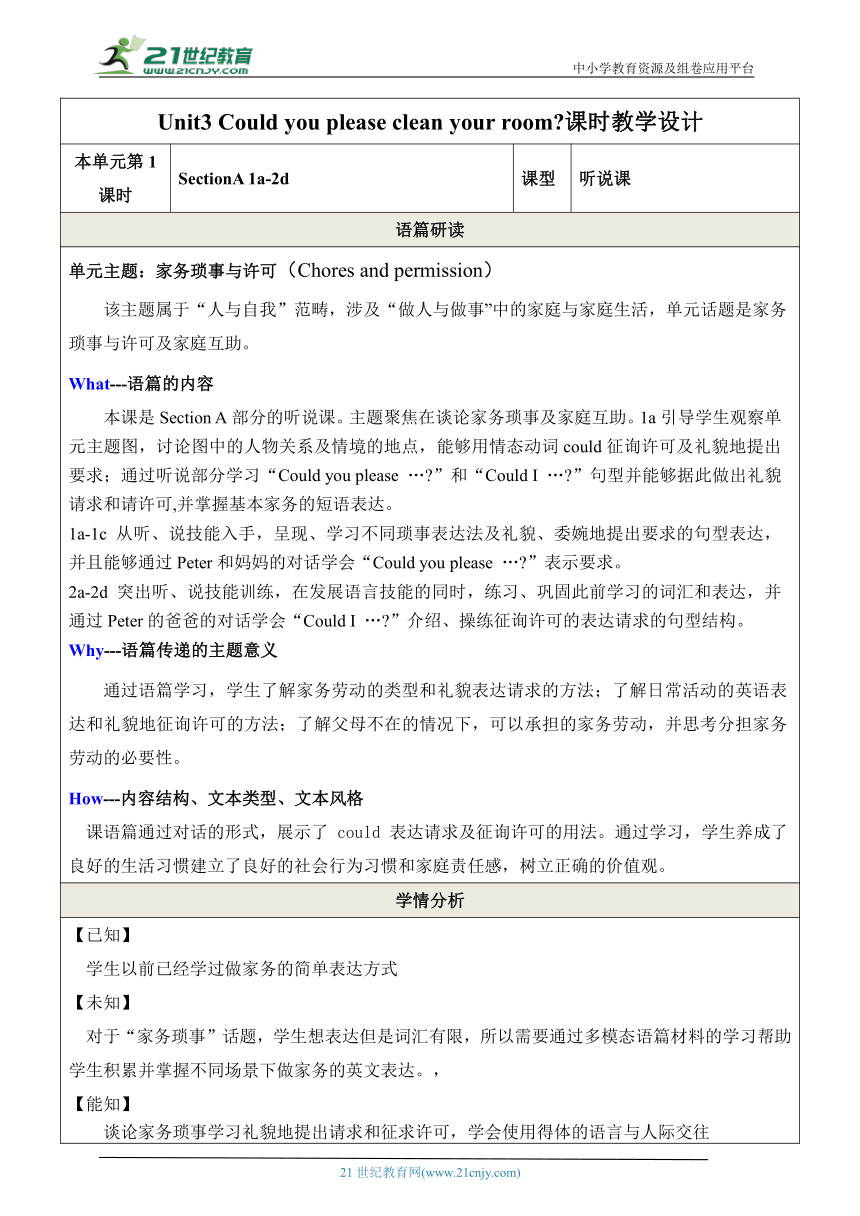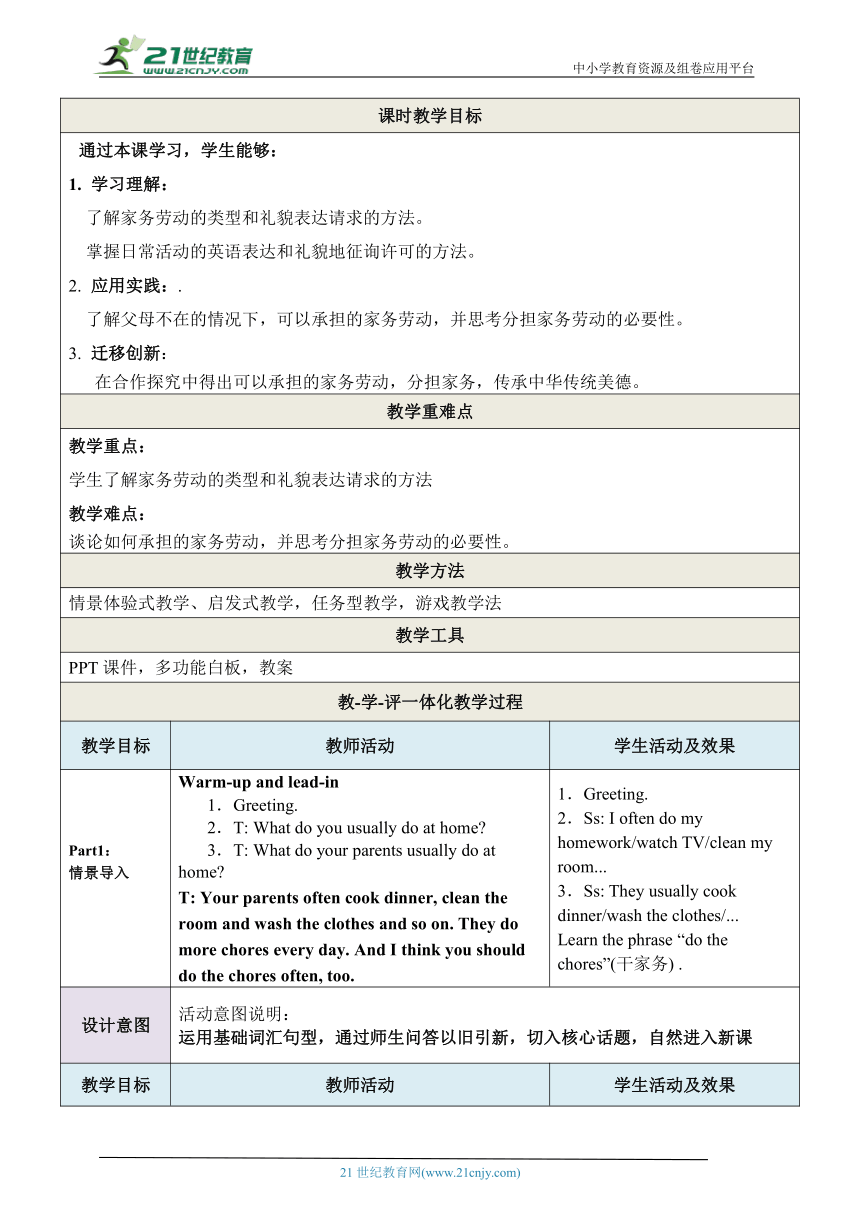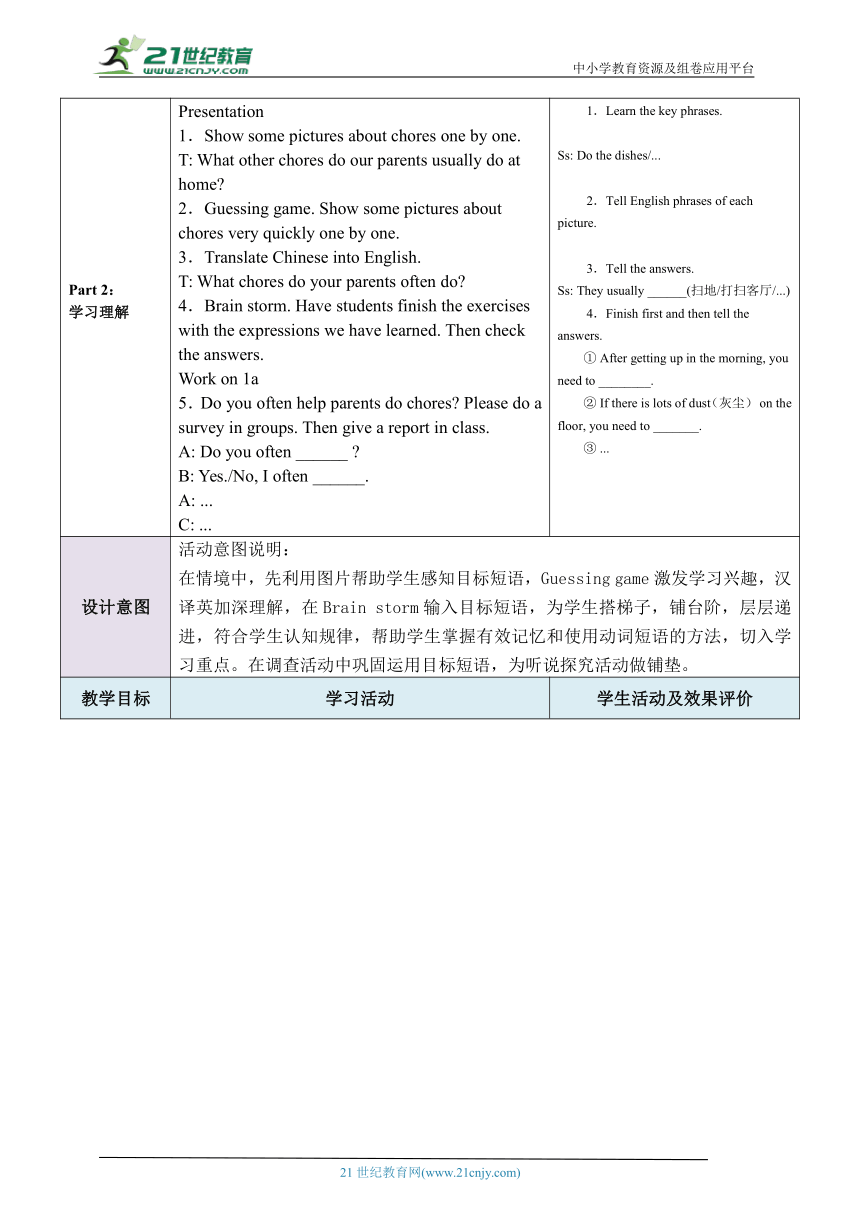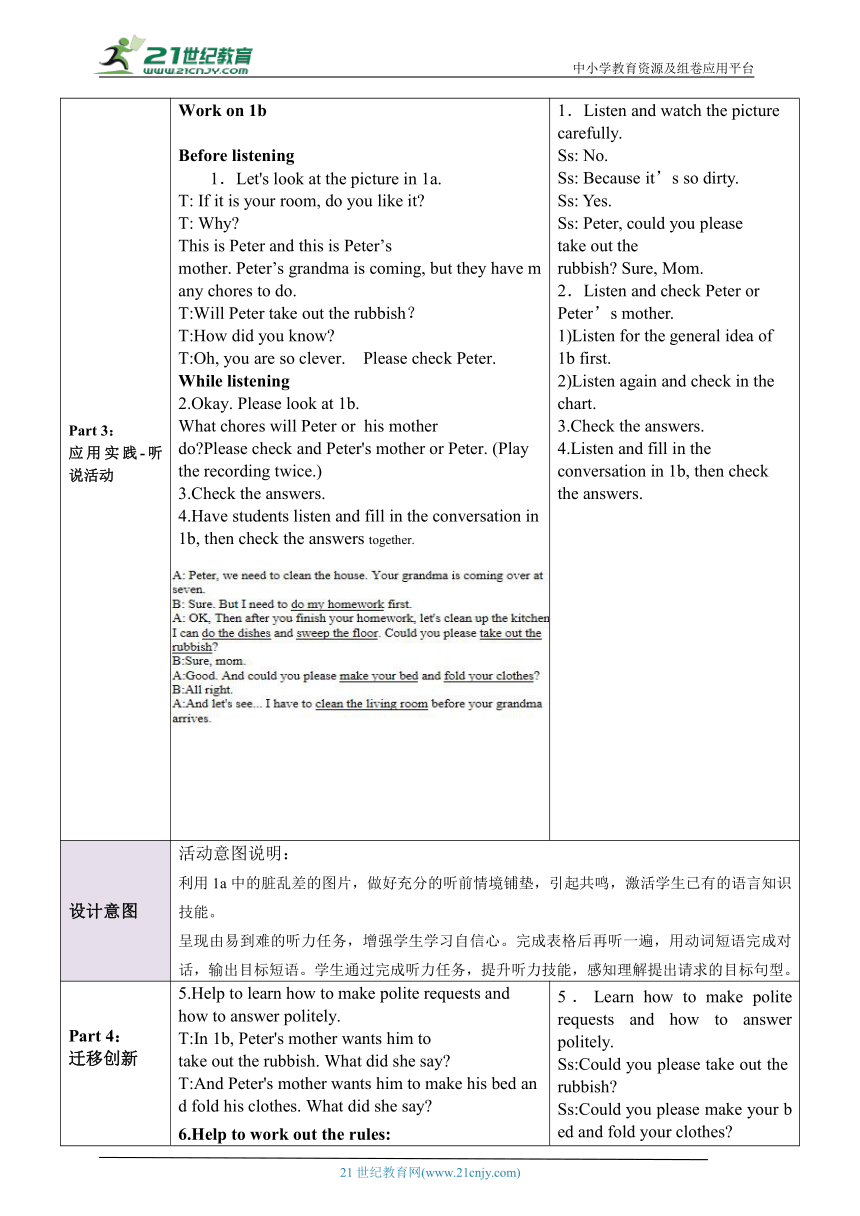(新课标 Unit 3 Section A 1a-2d 表格式教学设计(人教版八年级下Unit 3 Could you please clean your room?).
文档属性
| 名称 | (新课标 Unit 3 Section A 1a-2d 表格式教学设计(人教版八年级下Unit 3 Could you please clean your room?). |

|
|
| 格式 | docx | ||
| 文件大小 | 366.9KB | ||
| 资源类型 | 试卷 | ||
| 版本资源 | 人教新目标(Go for it)版 | ||
| 科目 | 英语 | ||
| 更新时间 | 2024-03-05 21:37:56 | ||
图片预览




文档简介
中小学教育资源及组卷应用平台
Unit3 Could you please clean your room 课时教学设计
本单元第1课时 SectionA 1a-2d 课型 听说课
语篇研读
单元主题:家务琐事与许可(Chores and permission) 该主题属于“人与自我”范畴,涉及“做人与做事”中的家庭与家庭生活,单元话题是家务琐事与许可及家庭互助。 What---语篇的内容 本课是Section A部分的听说课。主题聚焦在谈论家务琐事及家庭互助。1a引导学生观察单元主题图,讨论图中的人物关系及情境的地点,能够用情态动词could征询许可及礼貌地提出要求;通过听说部分学习“Could you please … ”和“Could I … ”句型并能够据此做出礼貌请求和请许可,并掌握基本家务的短语表达。 1a-1c 从听、说技能入手,呈现、学习不同琐事表达法及礼貌、委婉地提出要求的句型表达,并且能够通过Peter和妈妈的对话学会“Could you please … ”表示要求。 2a-2d 突出听、说技能训练,在发展语言技能的同时,练习、巩固此前学习的词汇和表达,并通过Peter的爸爸的对话学会“Could I … ”介绍、操练征询许可的表达请求的句型结构。 Why---语篇传递的主题意义 通过语篇学习,学生了解家务劳动的类型和礼貌表达请求的方法;了解日常活动的英语表达和礼貌地征询许可的方法;了解父母不在的情况下,可以承担的家务劳动,并思考分担家务劳动的必要性。 How---内容结构、文本类型、文本风格 课语篇通过对话的形式,展示了 could 表达请求及征询许可的用法。通过学习,学生养成了良好的生活习惯建立了良好的社会行为习惯和家庭责任感,树立正确的价值观。
学情分析
【已知】 学生以前已经学过做家务的简单表达方式 【未知】 对于“家务琐事”话题,学生想表达但是词汇有限,所以需要通过多模态语篇材料的学习帮助学生积累并掌握不同场景下做家务的英文表达。, 【能知】 谈论家务琐事学习礼貌地提出请求和征求许可,学会使用得体的语言与人际交往
课时教学目标
通过本课学习,学生能够: 学习理解: 了解家务劳动的类型和礼貌表达请求的方法。
掌握日常活动的英语表达和礼貌地征询许可的方法。 应用实践:. 了解父母不在的情况下,可以承担的家务劳动,并思考分担家务劳动的必要性。 迁移创新: 在合作探究中得出可以承担的家务劳动,分担家务,传承中华传统美德。
教学重难点
教学重点: 学生了解家务劳动的类型和礼貌表达请求的方法 教学难点: 谈论如何承担的家务劳动,并思考分担家务劳动的必要性。
教学方法
情景体验式教学、启发式教学,任务型教学,游戏教学法
教学工具
PPT课件,多功能白板,教案
教-学-评一体化教学过程
教学目标 教师活动 学生活动及效果
Part1: 情景导入 Warm-up and lead-in Greeting. T: What do you usually do at home T: What do your parents usually do at home T: Your parents often cook dinner, clean the room and wash the clothes and so on. They do more chores every day. And I think you should do the chores often, too. 1.Greeting. 2.Ss: I often do my homework/watch TV/clean my room... 3.Ss: They usually cook dinner/wash the clothes/... Learn the phrase “do the chores”(干家务) .
设计意图 活动意图说明: 运用基础词汇句型,通过师生问答以旧引新,切入核心话题,自然进入新课
教学目标 教师活动 学生活动及效果
Part 2: 学习理解 Presentation 1.Show some pictures about chores one by one. T: What other chores do our parents usually do at home 2.Guessing game. Show some pictures about chores very quickly one by one. 3.Translate Chinese into English. T: What chores do your parents often do 4.Brain storm. Have students finish the exercises with the expressions we have learned. Then check the answers. Work on 1a 5.Do you often help parents do chores Please do a survey in groups. Then give a report in class. A: Do you often ______ B: Yes./No, I often ______. A: ... C: ... Learn the key phrases. Ss: Do the dishes/... Tell English phrases of each picture. Tell the answers. Ss: They usually ______(扫地/打扫客厅/...) Finish first and then tell the answers. ① After getting up in the morning, you need to ________. ② If there is lots of dust(灰尘) on the floor, you need to _______. ③ ...
设计意图 活动意图说明: 在情境中,先利用图片帮助学生感知目标短语,Guessing game激发学习兴趣,汉译英加深理解,在Brain storm输入目标短语,为学生搭梯子,铺台阶,层层递进,符合学生认知规律,帮助学生掌握有效记忆和使用动词短语的方法,切入学习重点。在调查活动中巩固运用目标短语,为听说探究活动做铺垫。
教学目标 学习活动 学生活动及效果评价
Part 3: 应用实践-听说活动 Work on 1b Before listening Let's look at the picture in 1a. T: If it is your room, do you like it T: Why This is Peter and this is Peter’s mother. Peter’s grandma is coming, but they have many chores to do.
T:Will Peter take out the rubbish?T:How did you know
T:Oh, you are so clever. Please check Peter. While listening 2.Okay. Please look at 1b. What chores will Peter or his mother do Please check and Peter's mother or Peter. (Play the recording twice.) 3.Check the answers. 4.Have students listen and fill in the conversation in 1b, then check the answers together. 1.Listen and watch the picture carefully. Ss: No. Ss: Because it’s so dirty. Ss: Yes. Ss: Peter, could you please take out the rubbish Sure, Mom. 2.Listen and check Peter or Peter’s mother. 1)Listen for the general idea of 1b first. 2)Listen again and check in the chart. 3.Check the answers. 4.Listen and fill in the conversation in 1b, then check the answers.
设计意图 活动意图说明: 利用1a中的脏乱差的图片,做好充分的听前情境铺垫,引起共鸣,激活学生已有的语言知识技能。 呈现由易到难的听力任务,增强学生学习自信心。完成表格后再听一遍,用动词短语完成对话,输出目标短语。学生通过完成听力任务,提升听力技能,感知理解提出请求的目标句型。
Part 4: 迁移创新 5.Help to learn how to make polite requests and how to answer politely.
T:In 1b, Peter's mother wants him to take out the rubbish. What did she say
T:And Peter's mother wants him to make his bed and fold his clothes. What did she say 6.Help to work out the rules: 5.Learn how to make polite requests and how to answer politely. Ss:Could you please take out the rubbish Ss:Could you please make your bed and fold your clothes 6.Work out the rules: A:Could you please... B:Sure. /Certainly./ All right./ No problem./ Yes, I'd love to. /... B:Sorry, I have to.../Sorry, I must.../ Sorry, I need to.../ Sorry, I will.../Sure, but...
设计意图 活动意图说明: 在教师的帮助下,自主探究听力材料中的提出礼貌请求的目标句型,理解句型含义,归纳句型结构及其肯定否定回答方式,切入重难点。
Part 5: 应用实践-听说活动 Work on 2a Before listening T: Peter often helps his mom do the chores. But now he wants go out for dinner. He asks his father if he can do four things. Read “Peter wants to...” While listening Have students listen and check “yes” or “no”. Play the recording twice. Organize students to check the answers. Work on 2b 2c T: Peter wants to stay out late and get a ride. But his father says “no”. Listen and draw lines to the reasons in 2a. When you listen, please pay more attention to “Could I ... ”. Listen to the teacher carefully and then read “Peter wants to...”in 2a. 2.The first time, listen for the main idea only. The second time, listen and check “yes” or “no”. Tell the answers. Listen, draw lines to the reasons in the chart in 2a. When listening, pay more attention to “Could I ... ” 4.Check the answers.
设计意图 承接上一环节,设置由易到难的听力任务,提升学生听力技能,在完成听力任务的过程中感知用于征得允许的重难点句型。
Part 6: 迁移创新 5.Have students compare and tell the differences. Could you please... Could I ... 6.Help to learn how to ask for permission and how to answer permission. T: Peter wants to go out for dinner, what did he say T: Peter wants to go to the movies, he said: 7.Let’s work out the rules: Work on 2d 8.Have students make different conversations between Peter and his father, then act out in pairs in class. A: Could I... B:Yes, you can./ Sure, that should be OK./... B: No, you can’t. 5.Tell the differences: Could you please... (用于礼貌的提出请求) Could I ... (用于征得允许) 6.Learn how to ask for permission and how to answer permission. Ss: Could I go out for dinner Ss: Could I go to the movies 7.Work out the rules: A: Could I... B:Yes, you can./ Sure, that should be OK./... B: No, you can’t. 8.Practice and then act out conversations between Peter and his father in pairs in class.
设计意图 通过感知、对比、理解帮助学生探究两种重难点句型的结构差异和语用功能差异,培训学生自主探究能力和总结能力,突破难点。
课时教学板书设计
Unit 3 SectionA 1a-2d Could you please ...... Could I ..... Do the chores Take out the rubbish Sweep the floor make the bed fold the cloth Clean the room
评价量表
评价内容自评师评互评听懂有关此话题的对话并且可以正确地获取信息。我写出本节课做出礼貌请求和许可的基本单词和固定短语我能制定志愿服务的周末计划
课时作业设计
作业内容 作业目标 设计意图
基础题: Remember what we learnt today. 掌握本节课的表示做出礼貌请求和许可的基本单词和固定短语 日常活动的英语表达和礼貌地征询许可
提高题: Preview the new words and phrases 练习用“Could you please … ”和“Could I … ”句型并能够据此做出礼貌请求和许可. 不同琐事表达法及礼貌、委婉地提出要求的句型表达
拓展题: Finish the exercises in weekly paper. 上网搜索其他的有关礼貌请求和许可的表达方式。 加深对本节课内容的理解和消化
课后反思(实施后填写)
本课是A部分的听说课。主题聚焦在谈论家务琐事及家庭互助。能够用情态动词could征询许可及礼貌地提出要求;从词汇角度上说,学生应当较为熟练地运用 与家庭活动及家务琐事相关的词汇及表达法。 1a引导学生观察单元主题图,讨论图中的人物关系及情境的地点,引导学生学习 与家务琐事相关的英文表达。 1a-1c 从听、说技能入手,呈现、学习不同琐事表达法及礼貌、委婉 地提出要求的句型表达,为词汇及句型结构的输入阶段。 2a-2d 突出听、说技能训练,在发展语言技能的同时,练习、巩固此前学习的词汇和表达,并介绍、操练征询许可的句型 结构,让学生将礼貌地提出要求和征询许可两种功能进行综合操练、运用。
21世纪教育网 www.21cnjy.com 精品试卷·第 2 页 (共 2 页)
21世纪教育网(www.21cnjy.com)
Unit3 Could you please clean your room 课时教学设计
本单元第1课时 SectionA 1a-2d 课型 听说课
语篇研读
单元主题:家务琐事与许可(Chores and permission) 该主题属于“人与自我”范畴,涉及“做人与做事”中的家庭与家庭生活,单元话题是家务琐事与许可及家庭互助。 What---语篇的内容 本课是Section A部分的听说课。主题聚焦在谈论家务琐事及家庭互助。1a引导学生观察单元主题图,讨论图中的人物关系及情境的地点,能够用情态动词could征询许可及礼貌地提出要求;通过听说部分学习“Could you please … ”和“Could I … ”句型并能够据此做出礼貌请求和请许可,并掌握基本家务的短语表达。 1a-1c 从听、说技能入手,呈现、学习不同琐事表达法及礼貌、委婉地提出要求的句型表达,并且能够通过Peter和妈妈的对话学会“Could you please … ”表示要求。 2a-2d 突出听、说技能训练,在发展语言技能的同时,练习、巩固此前学习的词汇和表达,并通过Peter的爸爸的对话学会“Could I … ”介绍、操练征询许可的表达请求的句型结构。 Why---语篇传递的主题意义 通过语篇学习,学生了解家务劳动的类型和礼貌表达请求的方法;了解日常活动的英语表达和礼貌地征询许可的方法;了解父母不在的情况下,可以承担的家务劳动,并思考分担家务劳动的必要性。 How---内容结构、文本类型、文本风格 课语篇通过对话的形式,展示了 could 表达请求及征询许可的用法。通过学习,学生养成了良好的生活习惯建立了良好的社会行为习惯和家庭责任感,树立正确的价值观。
学情分析
【已知】 学生以前已经学过做家务的简单表达方式 【未知】 对于“家务琐事”话题,学生想表达但是词汇有限,所以需要通过多模态语篇材料的学习帮助学生积累并掌握不同场景下做家务的英文表达。, 【能知】 谈论家务琐事学习礼貌地提出请求和征求许可,学会使用得体的语言与人际交往
课时教学目标
通过本课学习,学生能够: 学习理解: 了解家务劳动的类型和礼貌表达请求的方法。
掌握日常活动的英语表达和礼貌地征询许可的方法。 应用实践:. 了解父母不在的情况下,可以承担的家务劳动,并思考分担家务劳动的必要性。 迁移创新: 在合作探究中得出可以承担的家务劳动,分担家务,传承中华传统美德。
教学重难点
教学重点: 学生了解家务劳动的类型和礼貌表达请求的方法 教学难点: 谈论如何承担的家务劳动,并思考分担家务劳动的必要性。
教学方法
情景体验式教学、启发式教学,任务型教学,游戏教学法
教学工具
PPT课件,多功能白板,教案
教-学-评一体化教学过程
教学目标 教师活动 学生活动及效果
Part1: 情景导入 Warm-up and lead-in Greeting. T: What do you usually do at home T: What do your parents usually do at home T: Your parents often cook dinner, clean the room and wash the clothes and so on. They do more chores every day. And I think you should do the chores often, too. 1.Greeting. 2.Ss: I often do my homework/watch TV/clean my room... 3.Ss: They usually cook dinner/wash the clothes/... Learn the phrase “do the chores”(干家务) .
设计意图 活动意图说明: 运用基础词汇句型,通过师生问答以旧引新,切入核心话题,自然进入新课
教学目标 教师活动 学生活动及效果
Part 2: 学习理解 Presentation 1.Show some pictures about chores one by one. T: What other chores do our parents usually do at home 2.Guessing game. Show some pictures about chores very quickly one by one. 3.Translate Chinese into English. T: What chores do your parents often do 4.Brain storm. Have students finish the exercises with the expressions we have learned. Then check the answers. Work on 1a 5.Do you often help parents do chores Please do a survey in groups. Then give a report in class. A: Do you often ______ B: Yes./No, I often ______. A: ... C: ... Learn the key phrases. Ss: Do the dishes/... Tell English phrases of each picture. Tell the answers. Ss: They usually ______(扫地/打扫客厅/...) Finish first and then tell the answers. ① After getting up in the morning, you need to ________. ② If there is lots of dust(灰尘) on the floor, you need to _______. ③ ...
设计意图 活动意图说明: 在情境中,先利用图片帮助学生感知目标短语,Guessing game激发学习兴趣,汉译英加深理解,在Brain storm输入目标短语,为学生搭梯子,铺台阶,层层递进,符合学生认知规律,帮助学生掌握有效记忆和使用动词短语的方法,切入学习重点。在调查活动中巩固运用目标短语,为听说探究活动做铺垫。
教学目标 学习活动 学生活动及效果评价
Part 3: 应用实践-听说活动 Work on 1b Before listening Let's look at the picture in 1a. T: If it is your room, do you like it T: Why This is Peter and this is Peter’s mother. Peter’s grandma is coming, but they have many chores to do.
T:Will Peter take out the rubbish?T:How did you know
T:Oh, you are so clever. Please check Peter. While listening 2.Okay. Please look at 1b. What chores will Peter or his mother do Please check and Peter's mother or Peter. (Play the recording twice.) 3.Check the answers. 4.Have students listen and fill in the conversation in 1b, then check the answers together. 1.Listen and watch the picture carefully. Ss: No. Ss: Because it’s so dirty. Ss: Yes. Ss: Peter, could you please take out the rubbish Sure, Mom. 2.Listen and check Peter or Peter’s mother. 1)Listen for the general idea of 1b first. 2)Listen again and check in the chart. 3.Check the answers. 4.Listen and fill in the conversation in 1b, then check the answers.
设计意图 活动意图说明: 利用1a中的脏乱差的图片,做好充分的听前情境铺垫,引起共鸣,激活学生已有的语言知识技能。 呈现由易到难的听力任务,增强学生学习自信心。完成表格后再听一遍,用动词短语完成对话,输出目标短语。学生通过完成听力任务,提升听力技能,感知理解提出请求的目标句型。
Part 4: 迁移创新 5.Help to learn how to make polite requests and how to answer politely.
T:In 1b, Peter's mother wants him to take out the rubbish. What did she say
T:And Peter's mother wants him to make his bed and fold his clothes. What did she say 6.Help to work out the rules: 5.Learn how to make polite requests and how to answer politely. Ss:Could you please take out the rubbish Ss:Could you please make your bed and fold your clothes 6.Work out the rules: A:Could you please... B:Sure. /Certainly./ All right./ No problem./ Yes, I'd love to. /... B:Sorry, I have to.../Sorry, I must.../ Sorry, I need to.../ Sorry, I will.../Sure, but...
设计意图 活动意图说明: 在教师的帮助下,自主探究听力材料中的提出礼貌请求的目标句型,理解句型含义,归纳句型结构及其肯定否定回答方式,切入重难点。
Part 5: 应用实践-听说活动 Work on 2a Before listening T: Peter often helps his mom do the chores. But now he wants go out for dinner. He asks his father if he can do four things. Read “Peter wants to...” While listening Have students listen and check “yes” or “no”. Play the recording twice. Organize students to check the answers. Work on 2b 2c T: Peter wants to stay out late and get a ride. But his father says “no”. Listen and draw lines to the reasons in 2a. When you listen, please pay more attention to “Could I ... ”. Listen to the teacher carefully and then read “Peter wants to...”in 2a. 2.The first time, listen for the main idea only. The second time, listen and check “yes” or “no”. Tell the answers. Listen, draw lines to the reasons in the chart in 2a. When listening, pay more attention to “Could I ... ” 4.Check the answers.
设计意图 承接上一环节,设置由易到难的听力任务,提升学生听力技能,在完成听力任务的过程中感知用于征得允许的重难点句型。
Part 6: 迁移创新 5.Have students compare and tell the differences. Could you please... Could I ... 6.Help to learn how to ask for permission and how to answer permission. T: Peter wants to go out for dinner, what did he say T: Peter wants to go to the movies, he said: 7.Let’s work out the rules: Work on 2d 8.Have students make different conversations between Peter and his father, then act out in pairs in class. A: Could I... B:Yes, you can./ Sure, that should be OK./... B: No, you can’t. 5.Tell the differences: Could you please... (用于礼貌的提出请求) Could I ... (用于征得允许) 6.Learn how to ask for permission and how to answer permission. Ss: Could I go out for dinner Ss: Could I go to the movies 7.Work out the rules: A: Could I... B:Yes, you can./ Sure, that should be OK./... B: No, you can’t. 8.Practice and then act out conversations between Peter and his father in pairs in class.
设计意图 通过感知、对比、理解帮助学生探究两种重难点句型的结构差异和语用功能差异,培训学生自主探究能力和总结能力,突破难点。
课时教学板书设计
Unit 3 SectionA 1a-2d Could you please ...... Could I ..... Do the chores Take out the rubbish Sweep the floor make the bed fold the cloth Clean the room
评价量表
评价内容自评师评互评听懂有关此话题的对话并且可以正确地获取信息。我写出本节课做出礼貌请求和许可的基本单词和固定短语我能制定志愿服务的周末计划
课时作业设计
作业内容 作业目标 设计意图
基础题: Remember what we learnt today. 掌握本节课的表示做出礼貌请求和许可的基本单词和固定短语 日常活动的英语表达和礼貌地征询许可
提高题: Preview the new words and phrases 练习用“Could you please … ”和“Could I … ”句型并能够据此做出礼貌请求和许可. 不同琐事表达法及礼貌、委婉地提出要求的句型表达
拓展题: Finish the exercises in weekly paper. 上网搜索其他的有关礼貌请求和许可的表达方式。 加深对本节课内容的理解和消化
课后反思(实施后填写)
本课是A部分的听说课。主题聚焦在谈论家务琐事及家庭互助。能够用情态动词could征询许可及礼貌地提出要求;从词汇角度上说,学生应当较为熟练地运用 与家庭活动及家务琐事相关的词汇及表达法。 1a引导学生观察单元主题图,讨论图中的人物关系及情境的地点,引导学生学习 与家务琐事相关的英文表达。 1a-1c 从听、说技能入手,呈现、学习不同琐事表达法及礼貌、委婉 地提出要求的句型表达,为词汇及句型结构的输入阶段。 2a-2d 突出听、说技能训练,在发展语言技能的同时,练习、巩固此前学习的词汇和表达,并介绍、操练征询许可的句型 结构,让学生将礼貌地提出要求和征询许可两种功能进行综合操练、运用。
21世纪教育网 www.21cnjy.com 精品试卷·第 2 页 (共 2 页)
21世纪教育网(www.21cnjy.com)
同课章节目录
- Unit 1 What's the matter?
- Section A
- Section B
- Unit 2 I'll help to clean up the city parks.
- Section A
- Section B
- Unit 3 Could you please clean your room?
- Section A
- Section B
- Unit 4 Why don't you talk to your parents?
- Section A
- Section B
- Unit 5 What were you doing when the rainstorm came
- Section A
- Section B
- Review of Units 1-5
- Unit 6 An old man tried to move the mountains.
- Section A
- Section B
- Unit 7 What's the highest mountain in the world?
- Section A
- Section B
- Unit 8 Have you read Treasure Island yet?
- Section A
- Section B
- Unit 9 Have you ever been to a museum?
- Section A
- Section B
- Unit 10 I've had this bike for three years.
- Section A
- Section B
